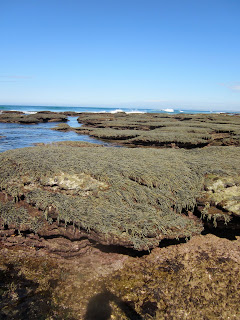Traveled to the beach 1.5 hours away to do some experiments for Blue Planet - Intro to Marine Environments.
We set out 50 meter tapes and randomly placed quadrats along it, looking at the different organisms in the quadrats in order to determine the biodiversity of the intertidal zone.
The rock platform that makes up the intertidal zone that we were working on.
Rosie and Alex working on counting the organisms within a quadrat.
The most populous seaweed, Hormosira banksii. It's edible too!
Some limpets and Hormosira
Using this cleverly devised ziptie, we can measure the wave velocity. The yellow cap is attached to a string that goes to the right end of the ziptie to a rubber band. The strength of the wave will stretch out the rubber band, pulling the ziptie locker thing along the plastic. We can then use that measurement to determine how strong the waves were.
Rock pool
This is one single organism. It takes water in one end (one of the purple blobs) and spits it out the other end (the other purple blob).
This orange clump on the underside of the rock is the same organism as above, just a TON of microscopic ones. The organism can either live in a colony, like this one, or be a single organism, like above.
Sea anemones!
They're opening up as the tide is coming in - so neat!
The Moomba Festival
Flinder's station
The Moomba Festival! Funny story - I was told by an Australian that "moomba" is a derogatory term for white people that the Aboriginals have. They were saying it so often around the white people, that the white people assumed it was another name for the part of the country they were in.
Crazy rides! The same as the ones in the US, except a LOT faster, more spins and turns and upside downs!
Fireworks!



































No comments:
Post a Comment